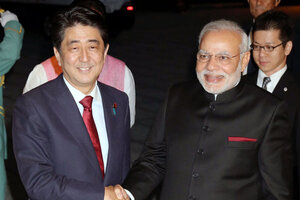Why Japan's Abe and India's Modi are Asia's new best friends
India's Prime Minister Narendra Modi arrives in Japan Saturday for a five-day state visit focused on trade and defense ties. India and Japan have mutual concerns about China's rise – but China is also both countries' largest trade partner.

Indian Prime Minister Narendra Modi, (r.), poses with his Japanese counterpart Shinzo Abe for photographers at the State Guest House in Kyoto, western Japan, Aug. 30. Modi arrived in Japan's ancient capital on Saturday to begin his five-day visit.
Kyodo News/AP
Tokyo
Even by Japan’s standards of hospitality, it is hard to recall a time in recent years when the visit of a foreign leader has been so eagerly awaited.
The blossoming economic and diplomatic ties between Tokyo and New Delhi were evident even before India’s prime minister, Narendra Modi, leaves Saturday for his first major diplomatic debut: a five-day state visit to Tokyo that will include talks with Prime Minister Shinzo Abe and an audience with the emperor and empress.
In a tweet posted in Japanese and English, Mr. Modi expressed “excitement” over his meeting with Mr. Abe, adding that he “deeply respects his leadership and enjoys a warm relationship with him.” Abe reciprocated, tweeting that “India has a special place in my heart.”
The two leaders will need to draw on that personal affinity as Modi arrives in the ancient capital of Kyoto for a visit framed by mutual concern over their unpredictable and increasingly assertive neighbor China. Japan and India face a tricky act balancing their apprehension over China’s vigorous territorial claims with their desires to court its huge markets.
India, locked in a Himalayan border dispute with China, is also concerned about China's closer ties with neighboring Sri Lanka and Pakistan. Diplomatically, Tokyo and Beijing remain all but estranged after two years of heightened tensions over sovereignty of the Senkaku-Diaoyu island chain in the South China Sea. Both countries fear Chinese naval aggression in the economically vital sea lanes of the East and South China seas.
Closer military cooperation between India and Japan will help correct the current “disequilibrium” in the region caused by China’s rapid rise, says Brahma Chellaney, a professor of strategic studies at the Center for Policy Research in New Delhi.
“China, India, and Japan form Asia’s strategic triangle. If side A were China, side B were India, and side C were Japan, the sum of B plus C will be always greater than A,” Mr. Chellaney says. “That is what is bringing Japan and India closer. That also is the reason why China sees a Japan-India axis as a strategic nightmare.”
Security cooperation
In the four months since he took office, Modi’s caution over Chinese naval power has quickly come to mirror that of Abe. Japan participated in recent joint exercises between India and the United States in the Pacific Ocean.
“Little else is more reassuring, and promising, for Japan than Delhi pronouncing that they are willing to collaborate with Tokyo not only on economic development but also on security provision in the vital sea passage ways from the Indian Ocean through the Straits of Malacca and even beyond,” says Tomohiko Taniguchi, a special adviser to the Abe administration.
Building closer Japan-India defense ties has acquired greater urgency amid signs that the US is eager for its allies to take more responsibility for regional security.
But it would be wrong to expect Modi’s visit to produce any agreement that smacks of a new anti-Chinese coalition, says Rory Medcalf, a former Australian diplomat in India and now director of the international security program at the Lowy Institute for International Policy in Sydney.
Tokyo and Delhi, Mr. Medcalf says, “will deepen cooperation in military exercises, intelligence, and even technology, but that does not mean they would put their direct interests at risk to help the other in a crisis.”
Nationalist leanings and firm friendship
The leaders' shared nationalist leanings and friendship will make it easier to navigating not only China but civil nuclear cooperation, another area of mutual interest.
“Abe and Modi share political values – free-market reforms, soft nationalism, and Asianism,” says Prof. Chellaney. “Not surprisingly, they have established a close personal rapport.”
As they contemplate the regional security environment over cups of bitter green tea at a traditional tea ceremony in Tokyo on Monday, Modi and Abe will be aware that their approach to China must look beyond security concerns if it is to stand any chance of success.
China is India’s biggest trading partner, with annual two-way trade accounting for about 9 percent of the country’s total commerce, according to India’s Commerce ministry. China is also Japan’s biggest trade partner, with trade between the two countries expected to grow for the first time for three years in 2014 after it was dented by fallout from the Senkaku-Diaoyu islands dispute.
The idea, therefore, that Japan’s recent diplomatic overtures to the US, Australia, and now India are the first step in a regional power grab are off the mark, according to officials close to Abe.
“The truth of the matter is that none of the above can afford to alienate China,” said one official on condition of anonymity. He predicted a slight ease in tensions as Beijing prepares to host the Asia-Pacific Economic Cooperation summit in November, but added that in the long-term, Japan and its regional partners “should continue to build their joint deterrence power over an extremely ambitious elephant in the room.”
Modi, who will be accompanied by a dozen businessmen who include the country’s richest man, Mukesh Ambani, will use the visit to boost exports and seek Japanese investment in Indian infrastructure, including a high-speed rail network linking the financial capital Mumbai with the commercial city of Ahmedabad.
In return he will offer exports of up to 2,000 tons a year of rare earth metals, thereby reducing Japan’s dependence on Chinese exports of the materials.

